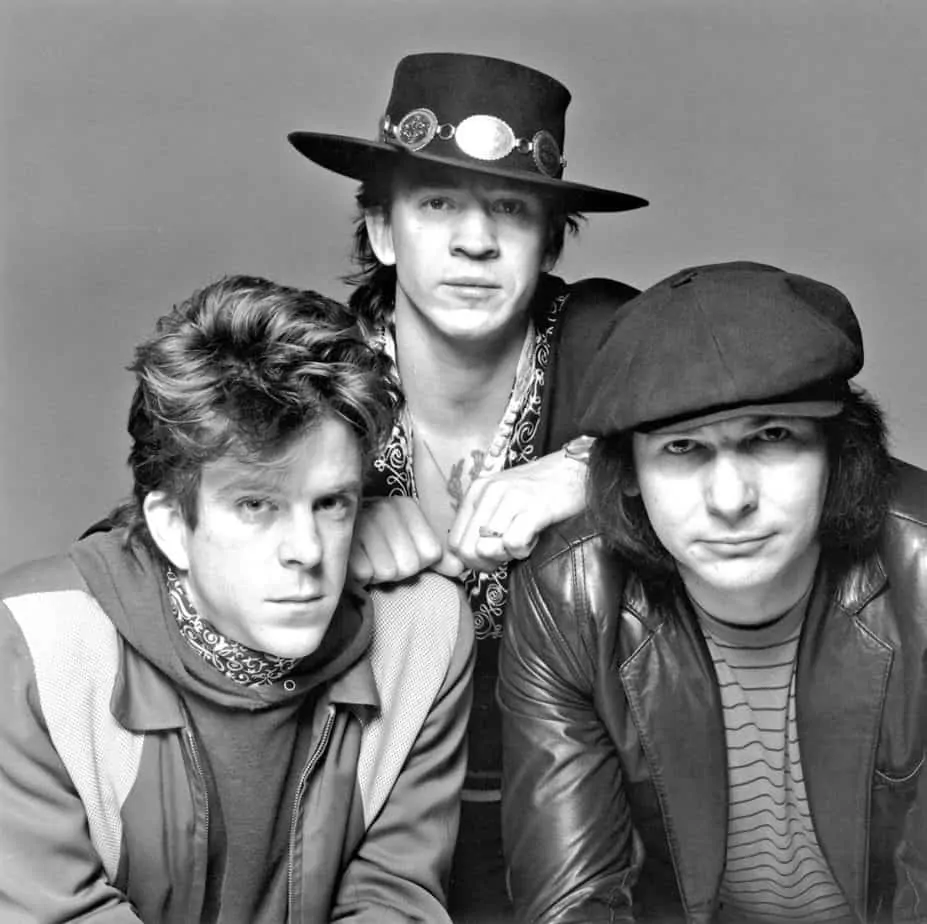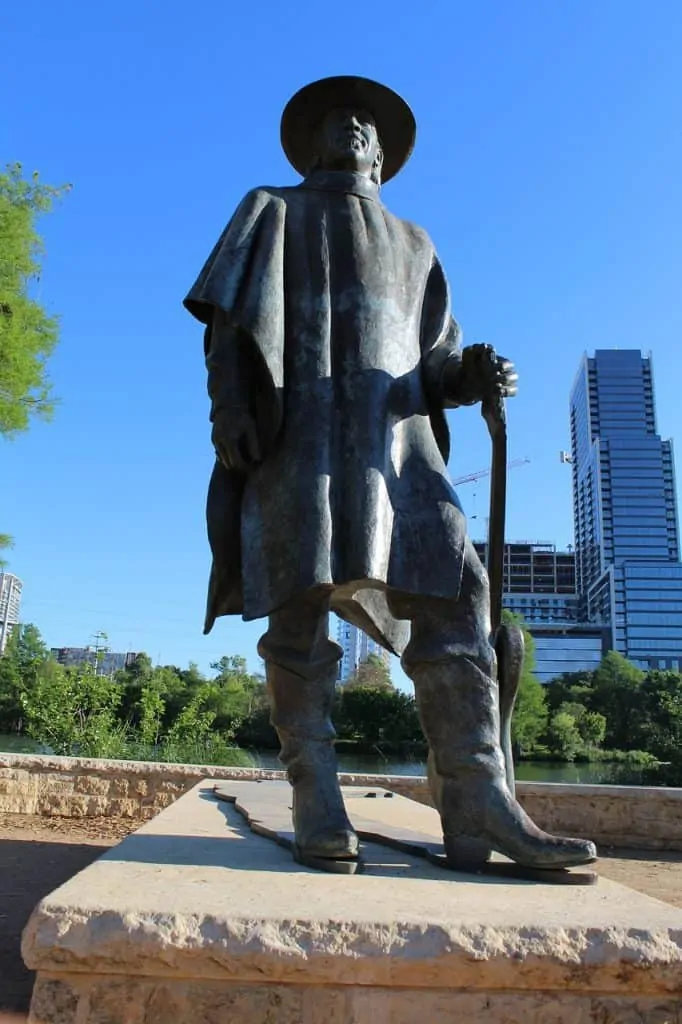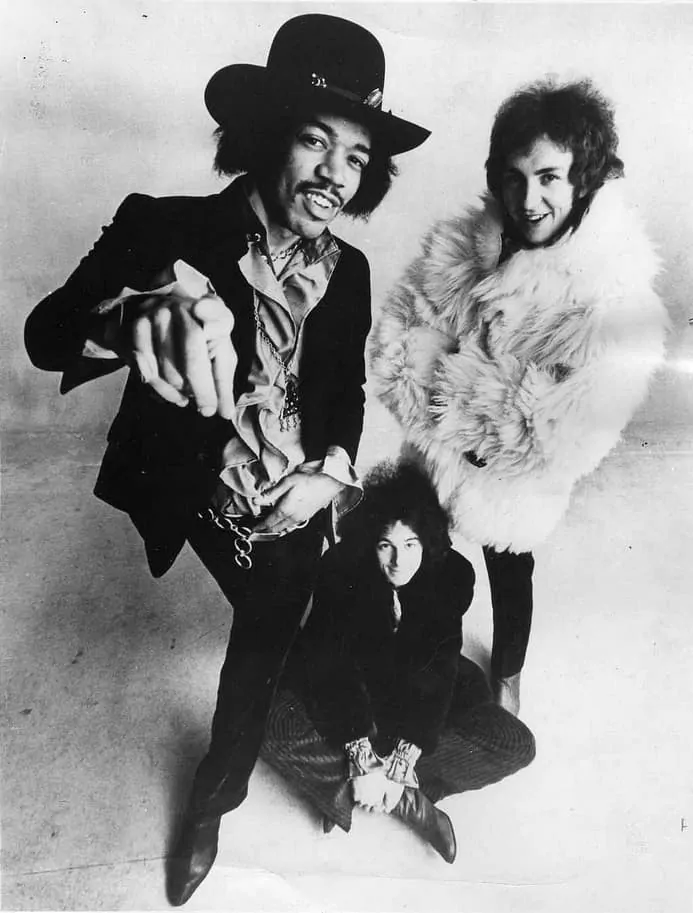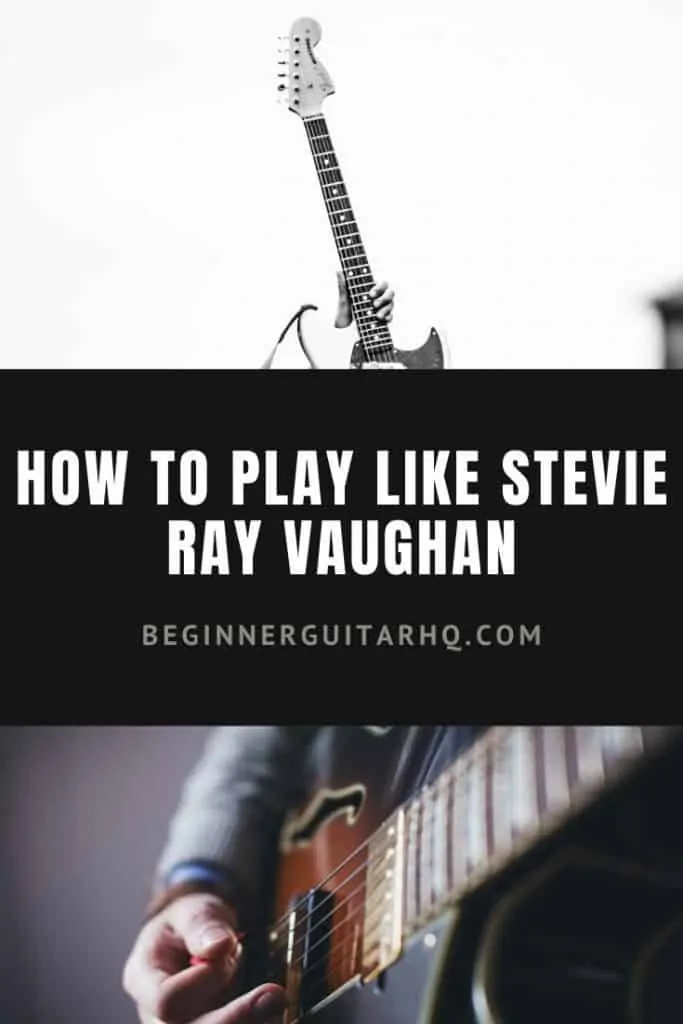When it comes to blues and blues rock, it’s impossible to ignore Stevie Ray Vaughan. A legendary guitar hero, made all the more mythical by his short time in the spotlight, he was famous for his raw edge and aggressive playing and sound as well as his on-stage appearance.
Stevie Ray Vaughan rescued blues in the 80’s, a time where the genre as a whole was starting to fade away, and turned it around to excite new audiences and recapture the interest of existing blues fans.
In this article, I’ll tell you about who he was, how he came into critical acclaim, and what got him there; letting you know what techniques he employed while playing, giving you an insight into his style and the famous Stevie Ray Vaughan guitar sound, and spilling the beans on his gear – as well as offering more affordable alternatives, so you can sound like Stevie without breaking the bank.
Contents
Background
Coming out of Texas, Stevie started playing young. At seven years old, he’d already picked up the guitar and by the time he was 20 he was making a name for himself playing clubs around Austin. Between 1977 and 1979, his first band Double Trouble started to form in a few different iterations, with different lineups, under different names. By the time 1980 rolled around, Stevie had become lead guitar and vocalist, and the name had changed to Stevie Ray Vaughan and Double Trouble.
They played a lot, generating popularity in the Texas club scene, before their producer recommended that they should play at the Montreux Jazz Festival way out in Switzerland. A long way from home, but it was absolutely worth it; this was the performance that took the band, and Stevie, from an unsigned club act to one of the most influential blues acts of all time, all thanks to somebody standing in the crowd that day — David Bowie.
Stevie Ray Vaughan’s guitar work, according to a quote from Bowie, “completely floored” him. He immediately contacted Stevie to get him to play on his upcoming sessions, and Stevie ended up playing on six of the eight tracks on David Bowie’s Let’s Dance – including a scorching hot, world-famous blues solo on the titular track. The single (and album) was a massive hit, spending three weeks at number one in the US – sort of unusual for the 80’s, a time where the blues was definitely a bit past its prime, and the neon-draped synth soundscapes of bands like The Human League, New Order, Soft Cell, Ultravox, Duran Duran and Erasure ruled the charts. Conquering these giants and going against the grain is definitely a testament to Stevie Ray Vaughan’s guitar prowess.
In 1983, with his name firmly planted into the spotlight, Stevie returned to Double Trouble and by 1986 years they had released three unbelievable albums: Texas Flood, Couldn’t Stand The Weather, and Soul to Soul.
Unfortunately, the rock n’ roll lifestyle eventually took its toll – between Soul to Soul being released in 1985 and his next release in 1989, Stevie boozed and struggled with addiction. In 1990, tragically just after he’d beaten his demons to release an album with his brother, Stevie Ray Vaughan died at the age of 35 in a helicopter crash. Just as fast and sudden as his rise to fame, it was all over.
Since then, he’s gone on to influence artists like John Mayer and Mike McCready (lead guitarist for grunge icons Pearl Jam), as well as being inducted into the Blues Hall of Fame and the Rock and Roll Hall of Fame along with Double Trouble. He’s had memorials erected in his honour, a statue in Austin, memorial concerts and has been recognised by Guitar World as one of their 100 greatest guitarists.
Stevie Ray Vaughan Guitar Technique Summary
Stevie uses a variety of classic techniques when playing, that come together to form the great recognisable and solid blues Stevie Ray Vaughan guitar sound that he’s famous for. It also means that when you do manage to imitate his style, you’ll know; it’ll feel and sound amazing, and you’ll learn a whole lot about how the hands have their own strengths but can produce something greater than the sum of their parts when working together. I’m going to break it down and look at each hand individually to give you an idea of what’s going on.
The Right Hand
If you put on Pride and Joy – arguably Stevie’s most famous record – you’ll hear within the first few seconds that Stevie was not afraid to play aggressive and physical guitar with his strumming hand. The famous Stevie Ray Vaughan guitar sound comes from the percussive way he is raking the pick through all the strings, employing some left-hand muting (we’ll cover it in a tick) to ensure that you only hear the notes he wants you to hear, regardless of him hitting every other string as well. It’s an incredibly rhythmic technique, employed by guitarists after him like John Frusciante of the Red Hot Chili Peppers.
It was perhaps especially important for Stevie to nail this technique in his days playing in a power trio in Stevie Ray Vaughan and Double Trouble, as he wasn’t going to be able to rely on another guitarist to handle the rhythm while he did the noodly bits over the top.
I’ve heard his right-hand technique described as a bit of a “train” like motion, and that’s certainly accurate – a constant beat, hitting strings on down and on up-strokes, keeps the songs he’s playing moving at a steady pace.
The Left Hand
To get the hang of Stevie Ray Vaughan’s guitar technique, you’ll crucially need to understand left hand muting. This is different from palm-muting because instead of relying on the heel or palm of your strumming hand, you’ll actually need to use the fingers of your fretting to hand to mute strings while you play. It’s tricky, but if you stick with it you’ll get the hang of it – and then be able to use it in your own riffs or to sound more like Stevie whenever you play any of his classic licks. To pull it off, try sticking your index finger on the D note of the A string (5th fret). While you’re fretting that, let your finger lay across the rest of the strings below it, but don’t push down – just apply enough pressure in your fingertip to properly fret the D note, and prevent all strings underneath from ringing.
Once you manage to get that sounding right, try planting your ring finger on the E note (7th fret). In this position, don’t try to mute any strings with your ring finger – you can still rely on your index finger to handle that for you. Just get your ring finger down, and lay your index finger across the strings to prevent them ringing out. It’s difficult at first to get used to how much or how little pressure you’ll need, but once you get used to it it’s like riding a bike.
Like other blues artists, Stevie Ray Vaughan used plenty of vibrato. Vibrato takes a totally boring note and shakes it up to keep it interesting – if you’re playing guitar, you should be using vibrato as often as possible, even just a little, to prevent audience boredom and make your solos and notes sound more human. To get it going, when you hit a note you should slightly twist your hand back and forth, bending the string up and down quickly and making the note ‘wobble’ slightly. You can also use the whammy bar on longer notes.
Bending is also a huge part of Stevie’s solo sound. Not just any run-of-the-mill bending though; Stevie’s aggressive, raw sound really shines when he’s employing double-stop bends. Double and Triple stops are a key element to getting that Stevie Ray Vaughan guitar sound, and they’re a mainstay in the wider blues and jazz communities too – but you don’t always hear double-stop bends. They’re mean, they’re rough and they cause a gritty, fiery distortion that’s unmistakable, and Stevie Ray Vaughan used them in spades. Switch to the bridge pickup, use your ring finger and pinky to play the twelfth frets of the G and B strings, and bend them up a full step – you’ll hear the way the notes fight with each other.
Jimi Hendrix was a key influence on Stevie Ray Vaughan – Jimi Hendrix experience 1968 | Warner/Reprise Records
Stevie Ray Vaughan Guitar Style & Sound
While the Stevie Ray Vaughan guitar sound is unique and recognisable, it does shift and change – and is built on his influences. Jimi Hendrix was Stevie’s primary influence. You can hear it in his playing, from the dirtiest of blues shuffles to the soft, flowing, reverb-soaked Lenny. You can learn a little more about Jimi Hendrix on this site – an artist worth knowing for anybody looking to play guitar.
However, he also took influence from older artists – some of them being Hendrix’s influences – including Albert King (whom he actually played alongside at one point), Lightning Hopkins, B. B. King, Chuck Berry, Johnny Winter, and Muddy Waters. Not content to just stick to one genre though, he was also influenced by jazz guitarists like the legendary Wes Montgomery.
He spent a lot of time in E flat tuning, utilising that classic flat-tuned strat sound, and used notably very heavy gauge strings (0.58 – 0.13s) to allow for a bendy, thick sound full of low-end grit but still able to pick up a little screaming in the high notes – which gave him his signature Stevie Ray Vaughan guitar sound.
While he certainly had a delicate, more melodic jazz side, Stevie Ray Vaughan is known, alongside Double Trouble, mainly for his violent, macho and in-your-face guitar tone and style as well as his gritty, emotional voice. That explosive guitar playing allowed him to resuscitate a stuffy and dying blues genre, play on chart-topping records (even have a chart topping single of his own), and solidify himself as one of the true guitar greats.
Stevie Ray Vaughan Guitar Gear – Guitar
I’ve already briefly mentioned that Stevie used notably heavy gauge strings, but they were a key part of his sound so let’s take a bit of a closer look at them. Vaughan used strings of thickness between 0.58 and 0.13 in thickness, but at times went even thicker – according to a 1993 edition of Guitar Player, he played strings as thick as 0.74 at one point. It was known that his aggressive strumming and bending would result in snapped strings fairly often (as seen in that famous clip of a roadie helping him change guitar mid-song), which may explain the choice to go for such thick cables for strings.
He largely stuck to Fender Stratocasters, his three most famous being Yellow, Red and of course the famous Stevie Ray Vaughan guitar “Number One”. While it is possible to grab a signature model based on Number One from Fender, it’ll set you back a decent amount. A mid range equivalent would be a Fender Player Strat, and a great budget option would be to opt for the Squier Classic Vibe – making sure you get it setup as SSS (three single-coil pickups).
Stevie Ray Vaughan Guitar Gear – Amp
Just like with his guitar gear, Stevie stood out with his choices for amplification too – explaining once when asked about his amps that he used “Fenders for distortion and the Marshall for clarity”, which is typically the opposite way round to most other guitarists. It wasn’t unusual for him to play through two amps at the same time when playing live, using one to push for his famous dirty distorted tone, and using the other to push the clean volume higher. When he was recording his final studio album (In Step), one of his techs reported that Stevie used 32 amps at once, and that when he played “the whole place would rattle”.
Stevie used a Marshall Club & Country amp, Fender Super Reverbs, and occasionally two Fender Vibroverbs, as well as a custom-built Dumble Steel String Singer that he nicknamed the “King Tone Console”. The Fender amps were vintage 60’s, making Stevie’s amp arsenal a very expensive one.
Amps that can replicate these tones are expensive, so it can be difficult to emulate these on a budget without using digital amps on your PC – something that can be an option if you’re recording your guitar – but I think you’ll be able to get close using the Fender Blues Jr. if you have to buy something physical.
Unfortunately, it’s going to be pretty tricky to capture the warmth and drive of his tone with a solid-state amp (You can check out the differences between solid-state vs tube amps here) – which is going to make the amp a little more pricey than it could otherwise be.
Stevie Ray Vaughan Guitar Gear – Pedalboard
To recreate his tone, you won’t actually need a huge pedalboard – he kept that fairly straight-forward, employing mostly a drive (the inimitable Ibanez Tube Screamer) and a wah (he preferred Vox). He did use a Vibratone and naturally when looking to really wear his Hendrix influence on his sleeve he made use of a Dallas-Arbiter Fuzz Face pedal.
To recreate the Stevie Ray Vaughan guitar effects board, you can grab any Tube Screamer (Stevie moved with the times and generally stuck to the latest available model, so you can probably do the same comfortably instead of paying a premium to get vintage models), pick up a Vox wah (I’d recommend the V845 as I’ve personally used it and found it hard-wearing and practical), and get ahold of a fuzz pedal – I’ve got the Electro-Harmonix Big Muff, which might be a little too heavy on the fuzz – for relatively cheap.
I would recommend that you go for Fender’s Pinwheel Rotary Speaker Emulator Pedal to imitate the Vibratone sound – a little more pricey than the Vox and Tube Screamer, but definitely cheaper and easier than finding yourself a Vibratone.
Conclusion and Recommended Listening
Stevie Ray Vaughan is a true guitar hero. The Stevie Ray Vaughan guitar sound is iconic. Rescuing the blues, performing on mega-hits, innovating and developing an unmistakable and immediately recognisable sound and style, all while singing and playing lead and rhythm – it’s no wonder so many people look up to him.
To get into Stevie and Double Trouble, I’d recommend that you give the following tracks a listen:
- Pride and Joy
- Texas Flood
- Voodoo Child
- Scuttle Buttin’
- Cold Shot
- Mary Had a Little Lamb
- Tin Pan Alley
- Little Wing
- Couldn’t Stand the Weather
- Crossfire
- Lenny
And, if you haven’t already heard it, give David Bowie’s Let’s Dance a shot. Stevie’s outro solo is not easily forgotten.




